Abstract
This study used published relative risk estimates for birth defects, premature birth, and coronary heart disease associated with vitamin intake to project potential annual cost reductions in U.S. hospitalization charges. Epidemiological and intervention studies with relative risk estimates were identified via MEDLINE. Preventable fraction estimates were derived from data on the percentage of at-risk Americans with daily vitamin intake levels lower than those associated with disease risk reduction. Hospitalization rates were obtained from the 1992 National Hospital Discharge Survey. Charge data from the 1993 California Hospital Discharge Survey were adjusted to 1995 national charges using the medical component of the Consumer Price Index. Based on published risk reductions, annual hospital charges for birth defects, low-birth-weight premature births, and coronary heart disease could be reduced by about 40, 60, and 38%, respectively. For the conditions studied, nearly $20 billion in hospital charges were potentially avoidable with daily use of folic acid and zinc-containing multivitamins by all women of childbearing age and daily vitamin E supplementation by those over 50.
Full text
PDF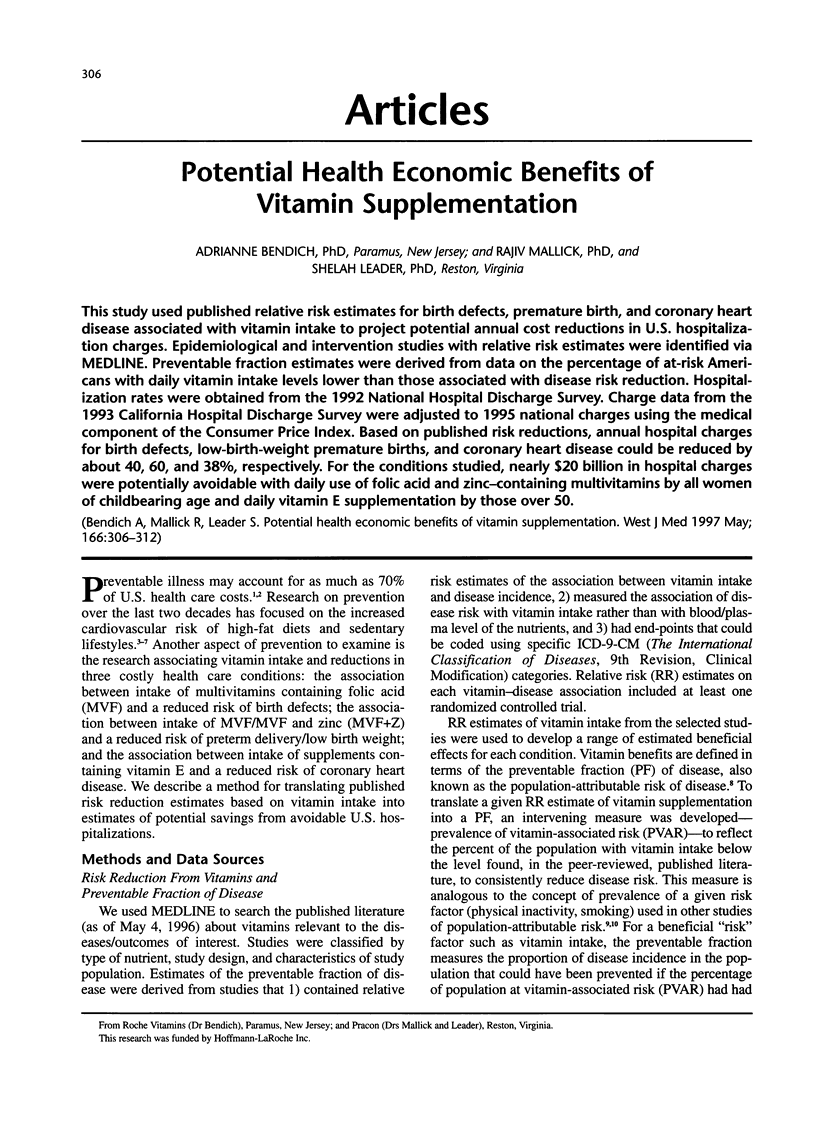
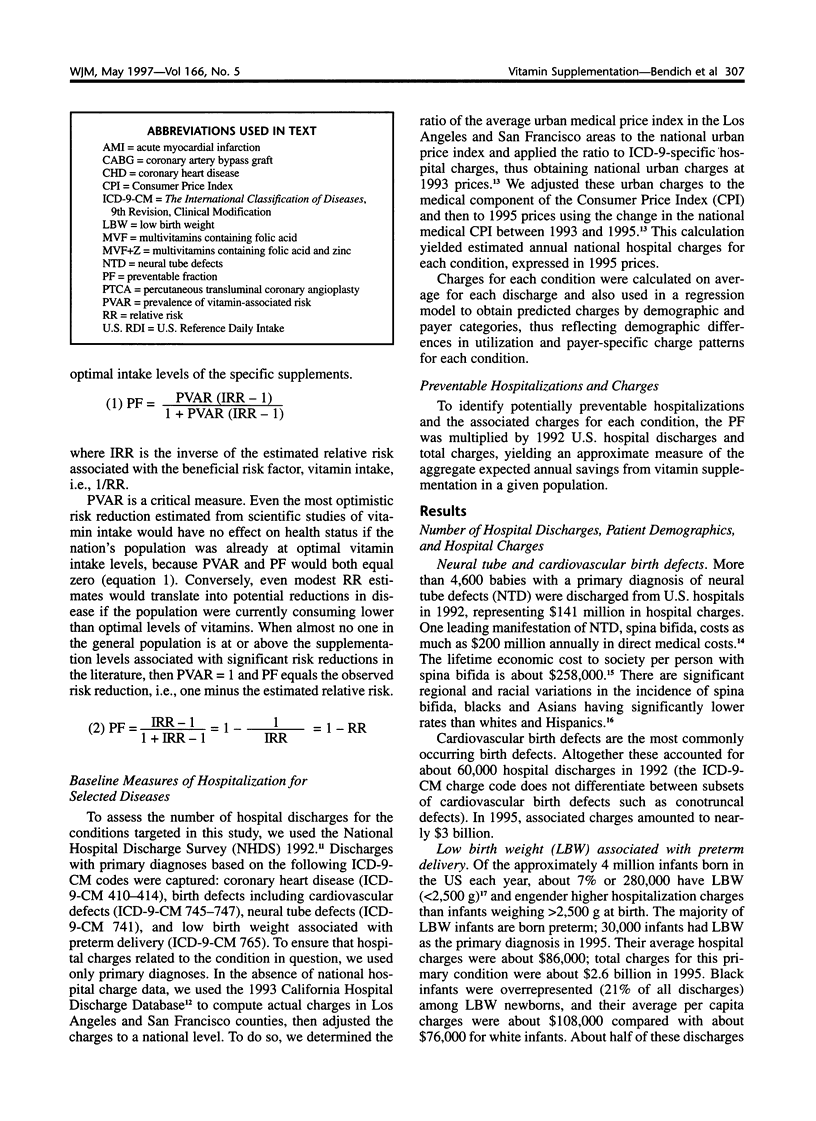
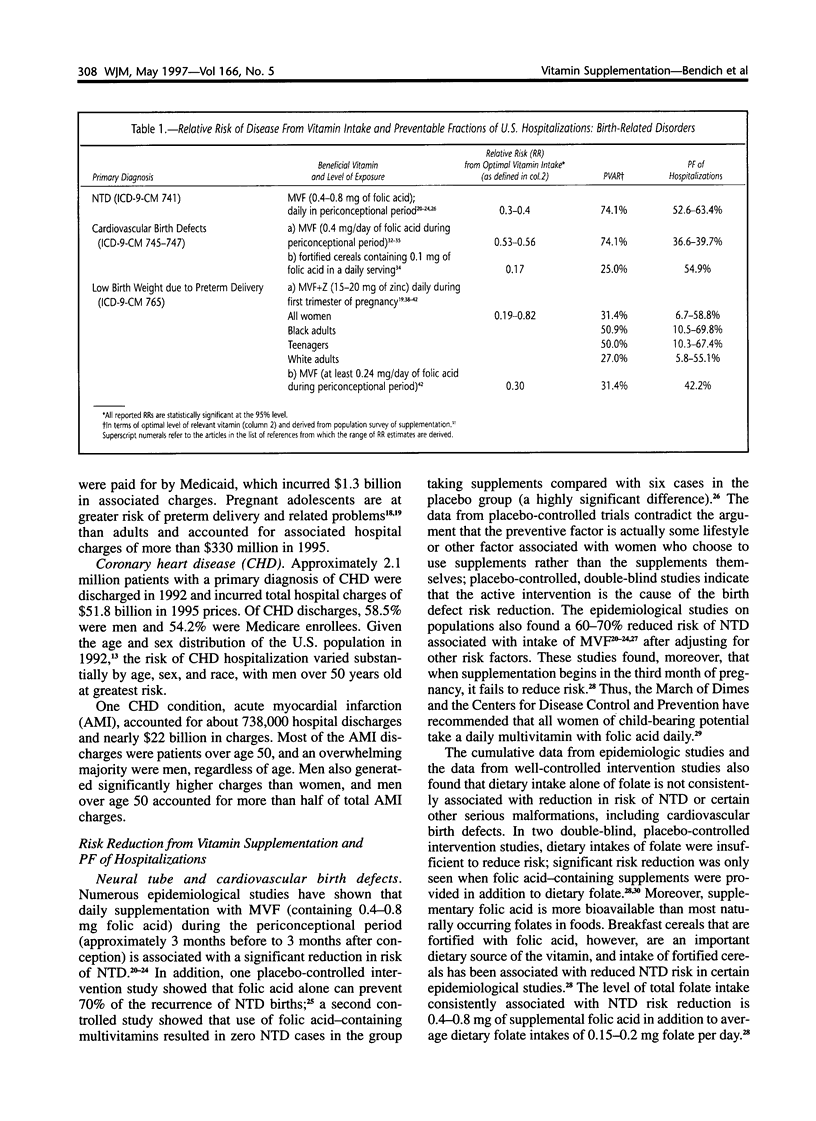
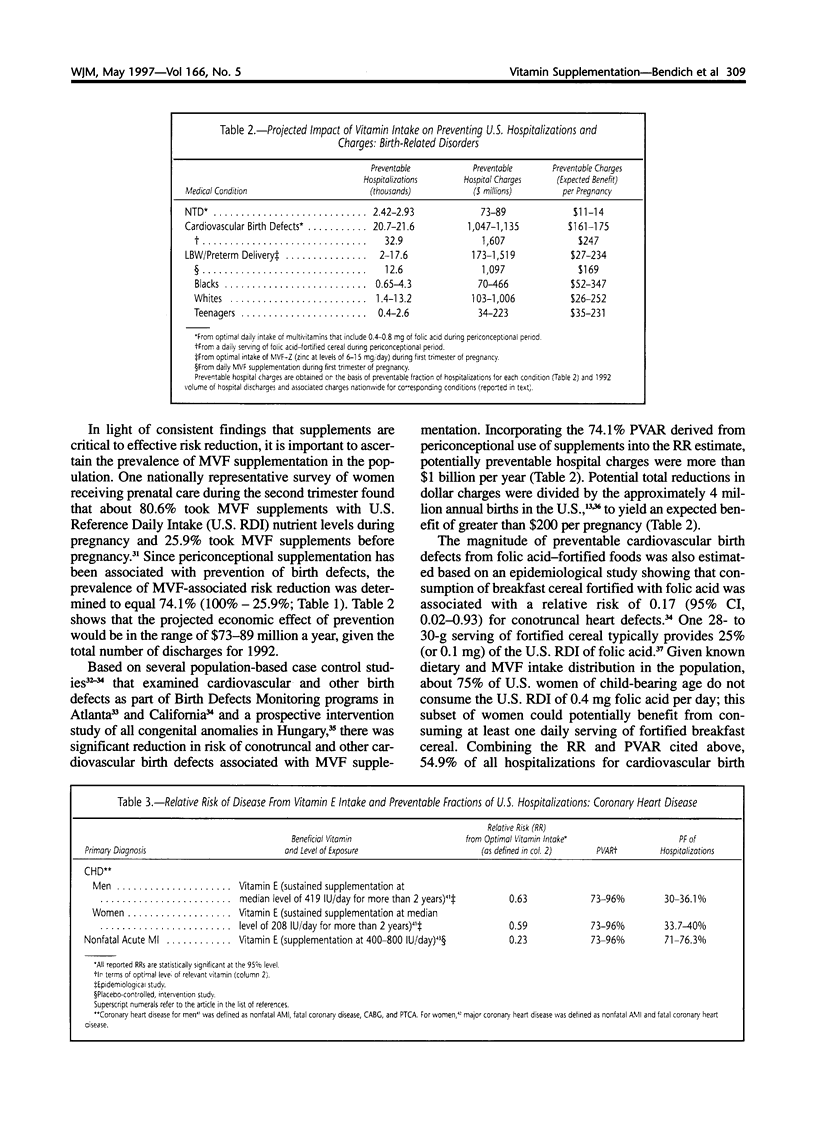
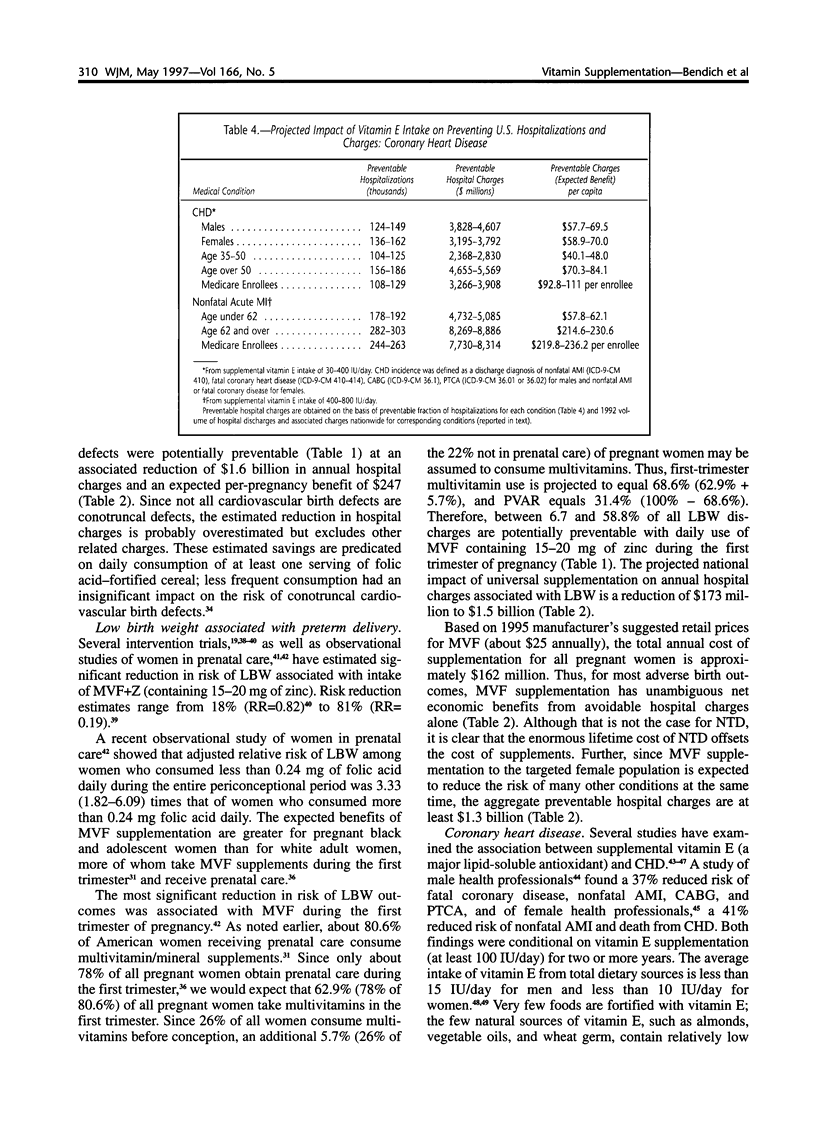
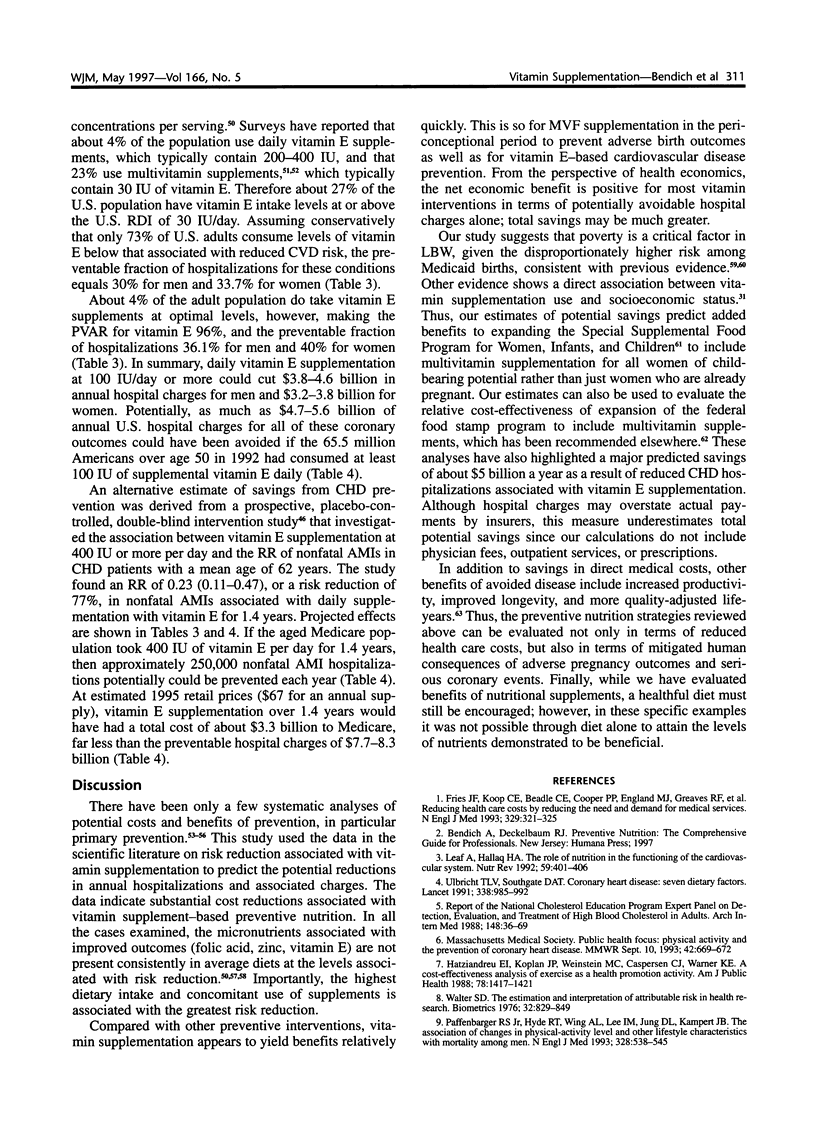
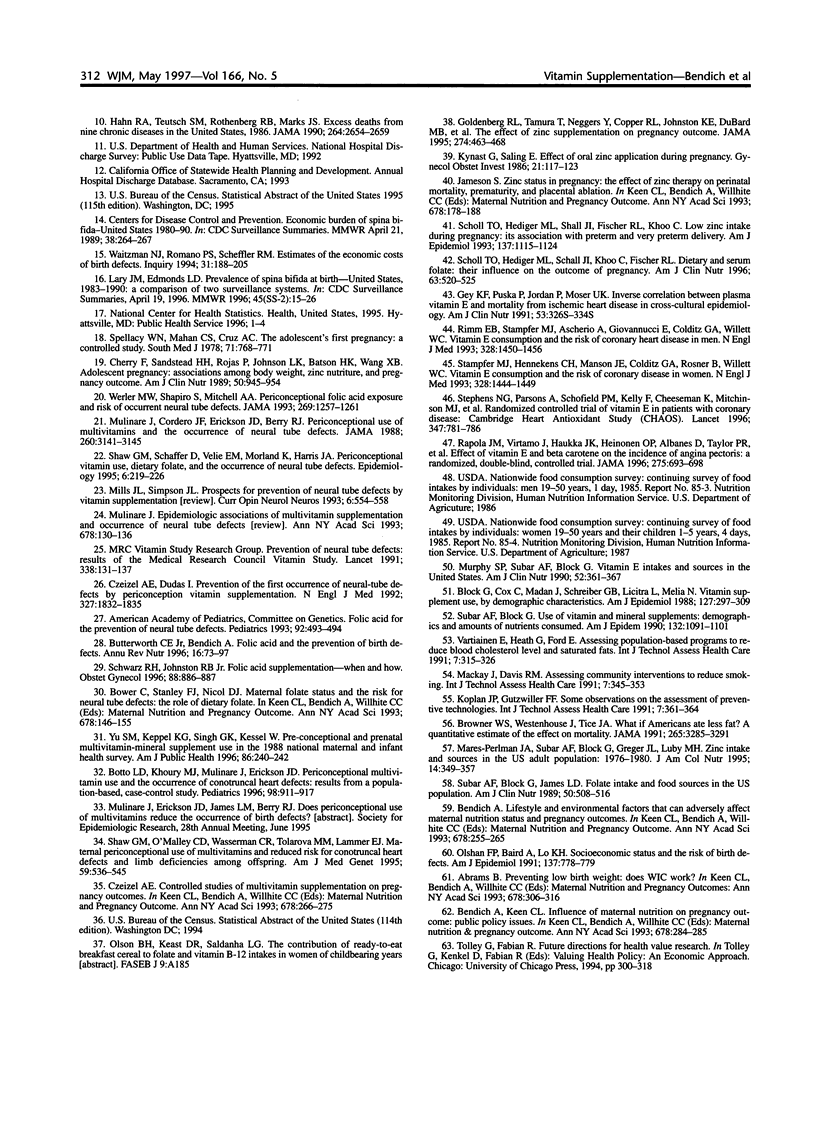
Selected References
These references are in PubMed. This may not be the complete list of references from this article.
- Abrams B. Preventing low birth weight: does WIC work? A review of evaluations of the special supplemental food program for women, infants, and children. Ann N Y Acad Sci. 1993 Mar 15;678:306–316. doi: 10.1111/j.1749-6632.1993.tb26133.x. [DOI] [PubMed] [Google Scholar]
- Bendich A., Keen C. L. Influence of maternal nutrition on pregnancy outcome: public policy issues. Introduction to Part V. Ann N Y Acad Sci. 1993 Mar 15;678:284–285. doi: 10.1111/j.1749-6632.1993.tb26130.x. [DOI] [PubMed] [Google Scholar]
- Bendich A. Lifestyle and environmental factors that can adversely affect maternal nutritional status and pregnancy outcomes. Ann N Y Acad Sci. 1993 Mar 15;678:255–265. doi: 10.1111/j.1749-6632.1993.tb26127.x. [DOI] [PubMed] [Google Scholar]
- Block G., Cox C., Madans J., Schreiber G. B., Licitra L., Melia N. Vitamin supplement use, by demographic characteristics. Am J Epidemiol. 1988 Feb;127(2):297–309. doi: 10.1093/oxfordjournals.aje.a114805. [DOI] [PubMed] [Google Scholar]
- Botto L. D., Khoury M. J., Mulinare J., Erickson J. D. Periconceptional multivitamin use and the occurrence of conotruncal heart defects: results from a population-based, case-control study. Pediatrics. 1996 Nov;98(5):911–917. [PubMed] [Google Scholar]
- Bower C., Stanley F. J., Nicol D. J. Maternal folate status and the risk for neural tube defects. The role of dietary folate. Ann N Y Acad Sci. 1993 Mar 15;678:146–155. doi: 10.1111/j.1749-6632.1993.tb26117.x. [DOI] [PubMed] [Google Scholar]
- Browner W. S., Westenhouse J., Tice J. A. What if Americans ate less fat? A quantitative estimate of the effect on mortality. JAMA. 1991 Jun 26;265(24):3285–3291. [PubMed] [Google Scholar]
- Butterworth C. E., Jr, Bendich A. Folic acid and the prevention of birth defects. Annu Rev Nutr. 1996;16:73–97. doi: 10.1146/annurev.nu.16.070196.000445. [DOI] [PubMed] [Google Scholar]
- Cherry F. F., Sandstead H. H., Rojas P., Johnson L. K., Batson H. K., Wang X. B. Adolescent pregnancy: associations among body weight, zinc nutriture, and pregnancy outcome. Am J Clin Nutr. 1989 Nov;50(5):945–954. doi: 10.1093/ajcn/50.5.945. [DOI] [PubMed] [Google Scholar]
- Czeizel A. E. Controlled studies of multivitamin supplementation on pregnancy outcomes. Ann N Y Acad Sci. 1993 Mar 15;678:266–275. doi: 10.1111/j.1749-6632.1993.tb26128.x. [DOI] [PubMed] [Google Scholar]
- Czeizel A. E., Dudás I. Prevention of the first occurrence of neural-tube defects by periconceptional vitamin supplementation. N Engl J Med. 1992 Dec 24;327(26):1832–1835. doi: 10.1056/NEJM199212243272602. [DOI] [PubMed] [Google Scholar]
- Fries J. F., Koop C. E., Beadle C. E., Cooper P. P., England M. J., Greaves R. F., Sokolov J. J., Wright D. Reducing health care costs by reducing the need and demand for medical services. The Health Project Consortium. N Engl J Med. 1993 Jul 29;329(5):321–325. doi: 10.1056/NEJM199307293290506. [DOI] [PubMed] [Google Scholar]
- Gey K. F., Puska P., Jordan P., Moser U. K. Inverse correlation between plasma vitamin E and mortality from ischemic heart disease in cross-cultural epidemiology. Am J Clin Nutr. 1991 Jan;53(1 Suppl):326S–334S. doi: 10.1093/ajcn/53.1.326S. [DOI] [PubMed] [Google Scholar]
- Goldenberg R. L., Tamura T., Neggers Y., Copper R. L., Johnston K. E., DuBard M. B., Hauth J. C. The effect of zinc supplementation on pregnancy outcome. JAMA. 1995 Aug 9;274(6):463–468. doi: 10.1001/jama.1995.03530060037030. [DOI] [PubMed] [Google Scholar]
- Hahn R. A., Teutsch S. M., Rothenberg R. B., Marks J. S. Excess deaths from nine chronic diseases in the United States, 1986. JAMA. 1990 Nov 28;264(20):2654–2659. [PubMed] [Google Scholar]
- Hatziandreu E. I., Koplan J. P., Weinstein M. C., Caspersen C. J., Warner K. E. A cost-effectiveness analysis of exercise as a health promotion activity. Am J Public Health. 1988 Nov;78(11):1417–1421. doi: 10.2105/ajph.78.11.1417. [DOI] [PMC free article] [PubMed] [Google Scholar]
- Jameson S. Zinc status in pregnancy: the effect of zinc therapy on perinatal mortality, prematurity, and placental ablation. Ann N Y Acad Sci. 1993 Mar 15;678:178–192. doi: 10.1111/j.1749-6632.1993.tb26121.x. [DOI] [PubMed] [Google Scholar]
- Koplan J. P., Gutzwiller F. F. Some observations on the assessment of preventive technologies. Int J Technol Assess Health Care. 1991;7(3):361–364. doi: 10.1017/s0266462300005730. [DOI] [PubMed] [Google Scholar]
- Kynast G., Saling E. Effect of oral zinc application during pregnancy. Gynecol Obstet Invest. 1986;21(3):117–123. doi: 10.1159/000298940. [DOI] [PubMed] [Google Scholar]
- Lary J. M., Edmonds L. D. Prevalence of spina bifida at birth--United States, 1983-1990: a comparison of two surveillance systems. MMWR CDC Surveill Summ. 1996 Apr 19;45(2):15–26. [PubMed] [Google Scholar]
- Leaf A., Hallaq H. A. The role of nutrition in the functioning of the cardiovascular system. Nutr Rev. 1992 Dec;50(12):402–406. doi: 10.1111/j.1753-4887.1992.tb02491.x. [DOI] [PubMed] [Google Scholar]
- Mackay J., Davis R. M. Assessing community interventions to reduce smoking. Int J Technol Assess Health Care. 1991;7(3):345–353. doi: 10.1017/s0266462300005717. [DOI] [PubMed] [Google Scholar]
- Mares-Perlman J. A., Subar A. F., Block G., Greger J. L., Luby M. H. Zinc intake and sources in the US adult population: 1976-1980. J Am Coll Nutr. 1995 Aug;14(4):349–357. doi: 10.1080/07315724.1995.10718520. [DOI] [PubMed] [Google Scholar]
- Mills J. L., Simpson J. L. Prospects for prevention of neural tube defects by vitamin supplementation. Curr Opin Neurol Neurosurg. 1993 Aug;6(4):554–558. [PubMed] [Google Scholar]
- Mulinare J., Cordero J. F., Erickson J. D., Berry R. J. Periconceptional use of multivitamins and the occurrence of neural tube defects. JAMA. 1988 Dec 2;260(21):3141–3145. [PubMed] [Google Scholar]
- Mulinare J. Epidemiologic associations of multivitamin supplementation and occurrence of neural tube defects. Ann N Y Acad Sci. 1993 Mar 15;678:130–136. doi: 10.1111/j.1749-6632.1993.tb26115.x. [DOI] [PubMed] [Google Scholar]
- Murphy S. P., Subar A. F., Block G. Vitamin E intakes and sources in the United States. Am J Clin Nutr. 1990 Aug;52(2):361–367. doi: 10.1093/ajcn/52.2.361. [DOI] [PubMed] [Google Scholar]
- Paffenbarger R. S., Jr, Hyde R. T., Wing A. L., Lee I. M., Jung D. L., Kampert J. B. The association of changes in physical-activity level and other lifestyle characteristics with mortality among men. N Engl J Med. 1993 Feb 25;328(8):538–545. doi: 10.1056/NEJM199302253280804. [DOI] [PubMed] [Google Scholar]
- Rapola J. M., Virtamo J., Haukka J. K., Heinonen O. P., Albanes D., Taylor P. R., Huttunen J. K. Effect of vitamin E and beta carotene on the incidence of angina pectoris. A randomized, double-blind, controlled trial. JAMA. 1996 Mar 6;275(9):693–698. doi: 10.1001/jama.1996.03530330037026. [DOI] [PubMed] [Google Scholar]
- Rimm E. B., Stampfer M. J., Ascherio A., Giovannucci E., Colditz G. A., Willett W. C. Vitamin E consumption and the risk of coronary heart disease in men. N Engl J Med. 1993 May 20;328(20):1450–1456. doi: 10.1056/NEJM199305203282004. [DOI] [PubMed] [Google Scholar]
- Scholl T. O., Hediger M. L., Schall J. I., Fischer R. L., Khoo C. S. Low zinc intake during pregnancy: its association with preterm and very preterm delivery. Am J Epidemiol. 1993 May 15;137(10):1115–1124. doi: 10.1093/oxfordjournals.aje.a116615. [DOI] [PubMed] [Google Scholar]
- Scholl T. O., Hediger M. L., Schall J. I., Khoo C. S., Fischer R. L. Dietary and serum folate: their influence on the outcome of pregnancy. Am J Clin Nutr. 1996 Apr;63(4):520–525. doi: 10.1093/ajcn/63.4.520. [DOI] [PubMed] [Google Scholar]
- Schwarz R. H., Johnston R. B., Jr Folic acid supplementation--when and how. Obstet Gynecol. 1996 Nov;88(5):886–887. doi: 10.1016/0029-7844(96)00270-0. [DOI] [PubMed] [Google Scholar]
- Shaw G. M., O'Malley C. D., Wasserman C. R., Tolarova M. M., Lammer E. J. Maternal periconceptional use of multivitamins and reduced risk for conotruncal heart defects and limb deficiencies among offspring. Am J Med Genet. 1995 Dec 4;59(4):536–545. doi: 10.1002/ajmg.1320590428. [DOI] [PubMed] [Google Scholar]
- Shaw G. M., Schaffer D., Velie E. M., Morland K., Harris J. A. Periconceptional vitamin use, dietary folate, and the occurrence of neural tube defects. Epidemiology. 1995 May;6(3):219–226. doi: 10.1097/00001648-199505000-00005. [DOI] [PubMed] [Google Scholar]
- Spellacy W. N., Mahan C. S., Cruz A. C. The adolescent's first pregnancy: a controlled study. South Med J. 1978 Jul;71(7):768–771. doi: 10.1097/00007611-197807000-00009. [DOI] [PubMed] [Google Scholar]
- Stampfer M. J., Hennekens C. H., Manson J. E., Colditz G. A., Rosner B., Willett W. C. Vitamin E consumption and the risk of coronary disease in women. N Engl J Med. 1993 May 20;328(20):1444–1449. doi: 10.1056/NEJM199305203282003. [DOI] [PubMed] [Google Scholar]
- Stephens N. G., Parsons A., Schofield P. M., Kelly F., Cheeseman K., Mitchinson M. J. Randomised controlled trial of vitamin E in patients with coronary disease: Cambridge Heart Antioxidant Study (CHAOS) Lancet. 1996 Mar 23;347(9004):781–786. doi: 10.1016/s0140-6736(96)90866-1. [DOI] [PubMed] [Google Scholar]
- Subar A. F., Block G., James L. D. Folate intake and food sources in the US population. Am J Clin Nutr. 1989 Sep;50(3):508–516. doi: 10.1093/ajcn/50.3.508. [DOI] [PubMed] [Google Scholar]
- Subar A. F., Block G. Use of vitamin and mineral supplements: demographics and amounts of nutrients consumed. The 1987 Health Interview Survey. Am J Epidemiol. 1990 Dec;132(6):1091–1101. doi: 10.1093/oxfordjournals.aje.a115752. [DOI] [PubMed] [Google Scholar]
- Ulbricht T. L., Southgate D. A. Coronary heart disease: seven dietary factors. Lancet. 1991 Oct 19;338(8773):985–992. doi: 10.1016/0140-6736(91)91846-m. [DOI] [PubMed] [Google Scholar]
- Vartiainen E., Heath G., Ford E. Assessing population-based programs to reduce blood cholesterol level and saturated fats. Int J Technol Assess Health Care. 1991;7(3):315–326. doi: 10.1017/s0266462300005699. [DOI] [PubMed] [Google Scholar]
- Waitzman N. J., Romano P. S., Scheffler R. M. Estimates of the economic costs of birth defects. Inquiry. 1994 Summer;31(2):188–205. [PubMed] [Google Scholar]
- Walter S. D. The estimation and interpretation of attributable risk in health research. Biometrics. 1976 Dec;32(4):829–849. [PubMed] [Google Scholar]
- Werler M. M., Shapiro S., Mitchell A. A. Periconceptional folic acid exposure and risk of occurrent neural tube defects. JAMA. 1993 Mar 10;269(10):1257–1261. [PubMed] [Google Scholar]
- Yu S. M., Keppel K. G., Singh G. K., Kessel W. Preconceptional and prenatal multivitamin-mineral supplement use in the 1988 National Maternal and Infant Health Survey. Am J Public Health. 1996 Feb;86(2):240–242. doi: 10.2105/ajph.86.2.240. [DOI] [PMC free article] [PubMed] [Google Scholar]


